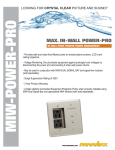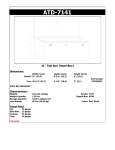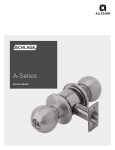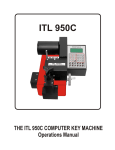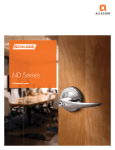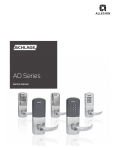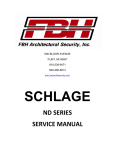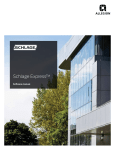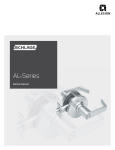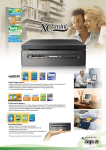Download Everest® full size cylinder
Transcript
Everest® full size cylinder Service manual Contents 5Introduction 6 Key control 6 Open keyways 6 Restricted keyways 6Primus® and Primus XP® integration 7 Mechanical overview 8 Everest full size interchangeable core 9 Modular cylinders 10 Key-in-knob to modular mortise and rim cylinder conversion 11Tailpieces 11 11 Cap Pin Locations Multiple tailpiece key-in-knob/key-in-lever cylinders 12 Tools and sales support items 13Keying 13 13 14 Rekeying when you have the old key (no master keying) Master keying Rekeying when you have no keys 15 Key bitting specifications 15 Pins and springs 16 Cutting Everest 29 keys on the blue punch 17 Upgrading to new top jaw 17 17 17 17 17 Red knob operation Black lever operation Upgrade package 40-074 Upgrading machines with a red knob Upgrading machines with a black lever 18 Tips for cutting Everest and Everest 29 keys 19 Everest key blanks 19 Operating keys 19 Everest C Family open keyways 20 Everest 29 key blanks 20 Operating keys 20 Everest 29 S Family open keyways Introduction Introduction Everest 29™ is the name given to a new family of patented key products by Schlage. Everest 29 and Everest® products are distinguished by the unique patented undercut groove milled into the right side of the key blade. Larger key bow Everest Everest 29 Undercut groove The first product in this family was the B family of small format interchangeable core (SFIC) introduced in November 1998 to retrofit 7-pin Best® style IC products. Full sized Everest C and D families followed shortly after. A different service manual (MS-C75) is devoted to SFIC. Everest 29 was introduced in August 2012 with a new undercut design that is patent protected until 2029. Everest 29 R, S, and T families are backward compatible with Everest B, C, and D keyways, respectively. This manual covers the Schlage Everest and Everest 29 cylinders, which are available in mortise, rim, key-in-knob and key-in lever versions. The Everest cylinders are also available in Schlage's 23-030 full size interchangeable core (FSIC). Except for the keyway and special pin which checks for the lip on the side of the key section, Everest cylinders are virtually identical to Schlage Classic cylinders with the C keyway, which have been around since 1935. Locksmiths and users get the benefits of the new Everest 29 patent without the need to invest in new pin kits, key machines or additional service equipment. However, a new top vise jaw is needed for the Blue Punch to hold all Everest C and Everest 29 S Family open key sections. A separate section of this manual provides details on how to upgrade the old Blue Punch. Note: D Family and T Family restricted keys can be cut on a different key bitting punch (40-099) because the top of the key blade is not straight. Additionally, a different service manual (MS-C75) is devote to SFIC products. 4 • Schlage • Everest full size cylinder service manual Undercut groove keyway and Everest logo on plug face Everest Hole in cylinder shell for check pin Everest 29 Key control Key control Since the late 1960's, patents on keys have been used primarily to prevent unauthorized key duplication. This is the case with Schlage's newest patented Everest 29 families. Both Everest and Everest 29 offer open keyways as well as families with restricted key control. Open keyways Everest C Family Keyways are protected by U.S. utility patents 5,715,717 and 5,809,816 and Everest 29 S Family Keyways are protected by U.S. utility patents 7,665,337 against unauthorized manufacture and distribution. However, the C Family and S Family keyways are readily available to the end user for fast and easy key duplication without any formalities. All C and S keyways are considered "open" keyways which means they can be stocked and sold by all locksmiths and contract hardware dealers. The purpose of the Everest C and Everest 29 S keyways is to guarantee the end-user genuine Schlage quality replacement keys and to provide commercial locksmiths and contract hardware dealers a group of keyways not available in home centers or retail key stands. Everest 29 S Family keyways are the default keyways for all new Schlage Commercial products and Schlage master key systems. Primus® and Primus XP® integration Primus and Primus XP cylinders are also available with Everest or Everest 29 keyways. The Everest Primus XP and Everest 29 Primus XP keys are downward compatible to operate the conventional Everest cylinders and Everest 29 cylinders covered in this manual. See the Schlage High Security Cylinders & Key Control Service Manual (SCGN-1001) for details on Everest 29 Primus XP cylinders. A portion of the undercut groove is milled away on all conventional Everest and Everest 29 keys to prevent them from being altered to operate an Everest Primus XP or Everest 29 Primus XP cylinder. Lip to lift check pin Lip removed to prevent Primus operation Restricted keyways For end-users who want restricted keys with patent protection, Schlage offers its Everest D and Everest 29 T Family keyways. Everest D and Everest 29 T Family keyways are protected by the same patents and require a letter of authorization from the end user. The difference between the C/S and D/T Families is just the keyway. Despite the fact that D and T Family keyways are restricted keyways they are still serviced in the same manner as the C and S Family keyways. D and T Family keyways can be reliably cut with the 40-099 key bitting punch. Due to the design of the key blade, a standard punch cannot be used. The keyway for each restricted D Family job is selected by Schlage and registered to the end user. Everest restricted key blanks, cut keys, cylinders and plugs are drop shipped directly to the end user (or a location specifically authorized by the end user). This creates positive key control by preventing dealers and distributors from having access to keys and cores without the end user’s permission. Schlage • Everest full size cylinder service manual • 5 Mechanical overview Mechanical overview Tumbler Springs Cylinder cross section Locked Top pins Unlocked Shell Tailpiece Master Pins (as needed) Bottom Pins Key Plug Check Pin Spring Check Pin Traditional cylinder (prior to July, 2010) Everest, Everest 29 and Primus Classic Traditional cams (prior to April, 2010) Everest, Everest 29 and Primus Classic Mortise cylinders use the Primus cam with one screw. 6 • Schlage • Everest full size cylinder service manual Retainer Cap Retainer Cap Pin Retainer Cap Pin Spring Traditional cylinder (after July, 2010) Classic Everest, Everest 29 and Primus Modular cams (introduced July, 2010) For cylinder housing sizes 1Z\v, 1Z\x, 1C\v” For cylinder housing sizes 1Z\,, 1C\,, 1B\,” Modular cylinder cams may be used with Classic, Everest 29, and Primus key sections. Use appropriate cam for cylinder housing size. Everest full size interchangeable core Everest full size interchangeable core C A D B Letter Description Part no. A Pin, Control C603-967 B Cylinder cap pin C603-827 Letter Description Part no. C Pin, actuating C603-964 D Ring, actuating C603-956 The Schlage Full Size Interchangeable Core (FSIC) design enables the full capabilities of a Schlage masterkey system. The extended tip of a control key will operate the control pin and retract the control lug by rotating the key 15 degrees of clockwise rotation. FSIC equipped locks, cylinders and cores are available mastekeyed or shipped 1-bitted from the factory. Keyed different is not allowed. By utilizing a special blank, a control key can be created at any level within the system. It is possible to have a control key that works the entire system as well as a control key that will only work one core. Control keys must be ordered separately. See Everest key blanks on page 18 and Everest 29 key blanks on page 19 for keying information. Schlage • Everest full size cylinder service manual • 7 Modular cylinders Modular cylinders Introduced in July 2010, the Schlage modular cylinder provides easy convertibility between key-in-lever to mortise and rim cylinders. These benefits make Schlage cylinder inventory flexible, reduce the size and cost of inventory, improve customer lead time, and increase customer satisfaction. With a few modular components in stock, the cylinder type and finish required will always be on hand. The modular cylinder accepts a tailpiece or a mortise cam. Product line availability: A, AL, B, CL, D, H, L, ND, S, S200, Kryptonite (PL, KS, KC), Mortise, and Rim. All competitive locks that accept Everest Primus XP or Everest 29 Primus XP will also accept the modular cylinders. Modular key-in-knob cylinder Modular rim cylinder 8 • Schlage • Everest full size cylinder service manual Modular mortise cylinder Modular cylinders Key-in-knob to modular mortise and rim cylinder conversion Modular housing interchangeability Housing Cam Cam screw Plug extension Part number Size Part number B520-721 1Z\," L583-474 B520-690 — B520-722 1Z\v" L583-475 B520-690 — B520-723 1C\," L583-474 B520-691 B590-298 B520-724 1Z\x" L583-475 B520-691 B590-298 B520-725 1B\," L583-474 B520-692 B590-299 B520-726 1C\v" L583-475 B520-692 B590-299 Cam L583-474 or L583-475 Cam Screw, 1” B520-692 Cam Screw, ³⁄₄” B520-691 Plug Extension B520-299 Cam L583-474 or L583-475 1³⁄₄" Plug Extension B520-298 1⁵⁄₈" 1¹⁄₂" Cam Screw, ¹⁄₂” B520-690 Cam L583-474 or L583-475 1³⁄₈" 1¹⁄₄" 1¹⁄₈" housing Schlage • Everest full size cylinder service manual • 9 Tailpieces Tailpieces Cap Pin Locations Vertical Horizontal Multiple tailpiece key-in-knob/key-in-lever cylinders A700-031 A301-338 C603-524 N523-022 AL, A, H, and D Knobs A and H Orbit (except 73) D Knob ND Levers Keyways Product Tailpiece Orientation Part number Classic 21-000 Everest A. H and D Knobs A700-031 Horizontal 40-100 Everest 29 80-216 AL Vertical A and H Orbit (except 73) A301-338 Horizontal D Knob C603-524 Horizontal ND Levers N523-022 Vertical 10 • Schlage • Everest full size cylinder service manual Tools and sales support items Tools and sales support items Pin kit 40-119 Key bitting punch 40-075 Vise jaw upgrade kit 40-074 ® E BLU CH N PU Y 1 20 P #B T CE AC 86 & 92 S OL , CA TO GE K LO AN OR QUALI OPR TO O LS 9 SS 8 IE OR 8 S 7 6 5 8 4 9 3 6 PR 7 2 5 1 3 O-L 4 2 0 0 ¨ OK 1 Contains all conventional pins and springs, modular follower M504-548, tweezers and M540-056 cylinder cap removal tool. Plug holder 40-066 Blue punch for cutting Obverse and Everest Open C family keys. Replaces jaw on Blue punch key machines manufactured before July 1999 to add Everest C family capability to Obverse family key machines. Key gauge 40-104 40-104 KEY GAGE 9 8 7 6 5 4 3 2 1 0 ¨ Has grooves for Primus sidebar. Included in 40-070 finger pin kit. Schlage • Everest full size cylinder service manual • 11 Keying Keying The following instructions assume that the reader has basic experience pinning conventional cylinders. The difference between Everest 29 and traditional cylinders is the check pin and spring located in the special chamber on the bottom of the plug. If using a key to remove the plug, the key will hold both the check pin and check pin spring in place. Rekeying when you have the old key (no master keying) 1. Remove the cam, tailpiece or other type of plug retainer. 2. Insert the old key and turn it slightly in either direction. 3. Push the plug out gently with a plug follower (M504-548 for modular cylinders). Key holds check pin in place 4. While the key is still in the plug to hold the check pin in place, discard the old pins. 5. Hold the check pin in the plug with your finger or thumb. Remove the old key and insert the new key. 6. The new key holds check pin in place while the bottom pins are installed and the plug is put back into the shell. 7. Lip raises check pin and holds it in plug. Reinstall the cam, tailpiece, etc. Master keying The master keying capacity of full size Everest or Everest 29 cylinders is the same as Schlage Classic cylinders: 4,096 theoretical changes per keyway using two step progression. The MACS is 7. When master keying Everest or Everest 29 cylinders, Schlage recommends using a setup key to reinstall the loaded plug. 4. IMPORTANT: Clear the cylinder shell of any remaining master pins. If master pins remain in the shell, the following problems may occur: • A key cannot be inserted or removed • One or more springs may get crushed and cause a future lockout A setup key can be made by cutting a key blank to a 9 depth in all positions. When the steeples between the cuts are removed, the setup key can hold the check pin in For removing plug place when removing the after shimming plug of a shimmed cylinder. 1. Insert any operating key and turn it slightly in either direction. Gently push the plug out with a plug follower. For the modular cylinder, we recommend the M504-548 follower. 2. Keeping the old key in the plug, discard the old pins. 3. Key holds check pin in place Hold the check pin in position with a finger or thumb. Remove the old key and insert the setup key. If you are certain that the cylinder was not previously master keyed, skip to step 5. 12 • Schlage • Everest full size cylinder service manual • Additional keys will operate the cylinder. Using the M504-548 follower for modular cylinders, slide the flat section of the follower inside the shell and rotate the flat section until it comes under the bible. All the master pins will then fall out. Rotate the flat section until it is opposite the bible and slide follower until about an inch is protruding from the front of the shell. Replace any weak or damaged springs. Load the proper size top pin based on the plug total (bottom pin + any master pins). A plug follower with a groove will help guide each spring and top pin into its chamber as you push the follower in from the back of the shell. (The 40-116 shell loading tool can make this process easier.) 5. Install new bottom and master pins into the plug. 6. Orient the plug so it is slightly turned with respect to the shell. Gently push the plug into the shell, pushing the plug follower out. 7. Test all keys for smooth operation. 8. Reinstall the cam, tailpiece, etc. Keying Rekeying when you have no keys When no key is available, use standard locksmith techniques to shim the cylinder open. However, the check pin must be taken into account. Follow these steps: 1. Using a pick or key blank, shim the six pins as usual. After the last pin is neutralized, the plug still cannot rotate or slide out because the check pin is engaged. 2. Leaving the shim in place, insert a setup key with no steeples between the 9 depth deep cuts. This unlocks the check pin and will also keep it from springing out of the plug in step 4. 3. Use the setup key to turn the plug slightly in either direction and remove the shim. 4. Push the plug out gently with a plug follower. For the modular cylinder, we recommend the M504-548 follower. For removing plug after shimming 5. While the setup key is still in the plug, discard the old pins. If you are certain that the cylinder was not previously master keyed, skip to step 7. 6. IMPORTANT: Clear the cylinder shell of any remaining master pins. If master pins remain in the shell, the following problems may occur: • A key cannot be inserted or removed • One or more springs will get crushed and cause a future lockout • Additional keys will operate the cylinder. Using the M504-548 follower for modular cylinders, slide the flat section of the follower inside the shell and rotate the flat section until it comes under the bible. All the master pins will then fall out. Rotate the flat section until it is opposite the bible and slide follower until about an inch is protruding from the front of the shell. Load the proper size top pin based on the plug total (bottom pin + any master pins). A plug follower with a groove will help guide each spring and top pin into its chamber as you push the follower in from the back of the shell. (The 40-116 shell loading tool can make this process easier.) 7. If you are master keying, leave the setup key in the plug. Otherwise, hold the check pin in position with your finger or thumb while removing the setup key and inserting the new operating key. 8. Install the new pins in the plug. 9. Orient the plug so it is slightly turned with respect to the shell. Gently push the plug into the shell, pushing the follower out. 10. Test all keys for smooth operation. 11. Reinstall the cam, tailpiece, etc. Schlage • Everest full size cylinder service manual • 13 Key bitting specifications Key bitting specifications The following specifications are the same for Schlage Classic keys, including Primus XP Classic Classic Everest 29 Everest 29 Primus XP Everest Everest Primus Code Card C45 for HPC 1200CM Code Machine Use of cutting wheel CW-14MC is not recommended 1.012" .8558" MACS = 7 Increment: 0.15" Progression: Two Step Blade Width: .343" Depth Tolerance: + .002" - 0 Spacing Tolerance: ± .001" .6996" .5434" .3872" .231" Root Depths 100° 0 .335" 5 .260" 1 .320" 6 .245" 2 .305" 7 .230" 3 .290" 8 .215" 4 .275" 9 .200" .031" 1 2 3 4 5 6 Pins and springs Bottom pins Master pins Size Length Part no. Size Length Part no. 0 .165" 34-300 2 .030" 34-202 1 .180" 34-301 3 .045" 34-203 2 .195" 34-302 4 .060" 34-204 3 .210" 34-303 5 .075" 34-205 4 .225" 34-304 6 .090" 34-206 5 .240" 34-305 7 .105" 34-207 6 .255" 34-306 8 .120" 34-208 7 .270" 34-307 9 .135" 34-209 8 .285" 34-308 9 .300" 34-309 14 • Schlage • Everest full size cylinder service manual Top pins Size Length Part no. Application 1 .235" 34-101 Plug total = 0, 1, 2, 3 2 .200" 34-102 Plug total = 4, 5, 6 3 .165" 34-103 Plug total = 7, 8, 9 Cutting Everest 29 keys on the blue punch Cutting Everest 29 keys on the blue punch In the close-up illustrations of the vise, notice the different positions of the top jaw required to engage the grooves and seat the different shapes of Schlage key sections properly. L-Handle Handle Obverse Key Sections Depth Bar C, CE, E, EF, F, FG, G, H, J, K, L Left end of vise Key Gauge Die Carriage Bottom Jaw Cover Plate Depth Number Most Everest and Everest 29 Key Sections: Red Knob Top Jaw Clamp Into Groove Between Ribs C100, C120, C123, C124, C135, C150 S100, S120, S123, S124, S135, S150 Bottom Jaw Loosen knob and lift jaw. Key Stop The original version of this popular key machine was developed in the mid-1970’s. Pro-Lok® is the most recent in the succession of companies that have manufactured the machine. Even if you have what appears to be an original Schlage punch (40-126), it was made by one of the earlier companies. The basic principles are the same for all versions of the machine, but there are minor differences in the vise jaws which affect the machine’s ability to cut Everest C & Everest 29 S Family keys. Machines made before July 1999 were not designed to hold Everest keys. Most of these machines have a thin top vise jaw made of stamped steel. Some machines will hold Everest keys, except sections with “45” in the designation (such as C145). Even the first generation solid steel jaw was produced before Everest keys existed and must be replaced. You may be able to alter your old style jaw by slightly elongating the hole, so it can travel far enough to engage in C145’s & S145 groove. However, this solution should only be a temporary measure until you install the 40-074 upgrade package with the properly shaped top jaw. Elongate Everest and Everest 29 "45" Sections: C145, C245, C345 S145, S245, S345 Loosen knob and lift jaw toward top of key blade. Not only must the top jaw engage in different places up and down the side of the various key sections, but the lever or knob screw must be tightened or loosened substantially. Loosening and tightening the lever or knob screw allows enough travel in the top jaw to accommodate the difference in thickness between Classic and Everest 29 key sections, and to adjust for the angles at which the top jaw sits. Schlage • Everest full size cylinder service manual • 15 Upgrading to new top jaw Upgrading to new top jaw Red knob operation Tighten the red knob on the Obverse key sections or loosen it enough to let the top jaw move up to grab into the high groove of C145, S145, or anything in between. Black lever operation Pro-Lok changed the red knob to a black clutching lever in 1998, before Everest keys existed. The lever can only swing about 180° before hitting the body of the machine. If the Blue Punch is used only to cut one type of Schlage key section, the lever’s travel may be set for fast secure clamping every time. The black lever does not allow the top jaw to travel from its lowest position (for Obverse keys), to an intermediate position (for clamping most of the Everest C and Everest 29 S Family keys), to the highest position required (for C145 and S145). Commercial locksmiths who cut a variety of Schlage key sections daily may find the continuous lever adjustment inconvenient. On most machines, the lever must be specifically adjusted for each of the three clamping positions. Upgrading machines with a red Long Angle knob 1. Unscrew the old knob. 2. Remove the old top jaw. 3. Install the new pieces. Install the jaw so the end with the longer angled portion is toward you. The end with the shorter angle has a lip to engage in the groove of the key section. 4. Screw on the new red knob. Upgrading machines with a black Hex socket lever 1. Swing the lever as far to the right as it will go. Lift up against spring pressure to disengage it from its screw. 2. Swing the lever back as far to the left as it will go and let it down to engage the screw. 3. Repeat this process as many times as necessary to unscrew the screw completely and remove the lever. A hex wrench may be helpful. Use the following procedure to back the screw out for Everest keys or to tighten the screw for Obverse keys: 1. Lift the lever against spring pressure to disengage it from the screw. 2. While disengaged, swing the lever to the left or right without turning the screw. 3. Let go of the lever and it snaps back into engagement with the screw. Upgrade package 40-074 A newly designed top jaw, red knob, spring, finishing washer and regular washer can be obtained from your Schlage or Pro-Lok distributor. Changing the top vise jaw has no effect on the accuracy of the machine. If the machine exhibits mechanical problems or cannot cut keys accurately, please contact your Pro-Lok distributor to arrange for your machine to be rebuilt. 16 • Schlage • Everest full size cylinder service manual Red Knob Lift up against spring Pressure while backing Screw out 4. Remove the lever, spring, washer and top jaw. 5. Install the new jaw so that the end with the longer angled portion is toward you. The end with the shorter angle engages the groove in the key milling. Finishing Washer Spring Washer Top Jaw 6. Reinstall the black lever or install the new red knob depending on your preference: The red knob screws into place. If reinstalling the black lever, use an Allen wrench to start the screw, then reverse the process used to remove the lever. To adjust the lever's final position and rotation, clamp a single key or key blank of the key section you will cut most frequently. Tips for cutting Everest and Everest 29 keys Tips for cutting Everest and Everest 29 keys After cutting several keys of each key section the procedure will become familiar. However, for the first few keys, please observe these important details: • Push the die carriage all the way to the right before inserting a key blank. If you clamp an Everest key before moving the carriage, its large bow may prevent the carriage from travelling far enough to allow the first cut to be correctly positioned. (Cut position will begin at #2 and incorrectly cut the key.) • Closely observe the proper engagement of the top jaw into the key section. If the jaw clamps on the surface of a rib or into the very bottom relief on an Everest key, the key jaw is not able to square up the blank in the vise, incorrectly cutting the key. S124 C124 C124, S124, C135, and S135 have tiny grooves. Be sure jaw engages into a groove. S145 C145 The position of the groove on C145, S145, C245, S245, C345, and S45 blanks requires loosening the knob and pushing the jaw toward the cutter to securely engage the groove. Schlage • Everest full size cylinder service manual • 17 Everest key blanks Everest key blanks Operating keys DO NOT DUPLICATE PAT. 5,715,717 35-002 35-009 Standard for D Family Standard Front for C Family Optional for C Family PAT. 5,715,717 35-002 and 35-009 Back DO NOT DUPLICATE PAT. 5,715,717 Front Back 35-015 Optional Plain Bow for C and D Families Control keys Cut keys 35-003 (Front) C O N T RO L 35-003 (Back) To order cut keys: Change "35" prefix to "48" or "49" DO NOT DUPLICATE PAT. 5,715,717 48 = Change keys and random or stock cut keys 49 = Factory master level key, including control keys Everest C Family open keyways All-Section Key C000 Multi-Section Keys C100 Multi-Section Keys C150 C134 C145 C135 C200 Multi-Section Keys C120 C125 New keyway systems begin here and continue to the right. 18 • Schlage • Everest full size cylinder service manual C124 C230 C123 Keyways and Single Section Keys C234 C235 C245 C345 Everest 29 key blanks Everest 29 key blanks Operating keys Conventional Standard front for S Family 35-270 Plain both sides 35-272 Standard for all control keys and all T Family keys Primus XP all Primus blanks require proper authorization Primus all Primus XP blanks require proper authorization Standard front 35-199-XP Operating 35-273-XP Control Standard front 35-199 Operating 35-273 Control Plain both sides 35-138-XP Control 35-215-XP Operating Optional for S Family 35-268 Operating 35-269 Control Back of all except 35-215-XP 35-138-XP Plain both sides 35-138 Control 35-215 Operating Back of all except 35-215 35-138 6-Pin Control Back of all except 35-272 Back of 35-269 Everest 29 S Family open keyways All-section key S000 Multi-section keys S100 Multi-section keys S150 S134 S145 S135 New master key systems begin here andn expand to the right S200 Multi-section keys S120 S125 S124 S230 S123 S234 S235 S245 S345 Stock keyway for commercial sales Schlage • Everest full size cylinder service manual • 19 About Allegion Allegion (NYSE: ALLE) creates peace of mind by pioneering safety and security. As a $2 billion provider of security solutions for homes and businesses, Allegion employs more than 7,800 people and sells products in more than 120 countries across the world. Allegion comprises 23 global brands, including strategic brands CISA®, Interflex®, LCN®, Schlage® and Von Duprin®. For more, visit www.allegion.com. © 2014 Allegion 008484, Rev. 03/14 www.allegion.com/us




















